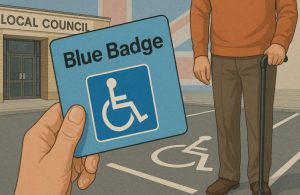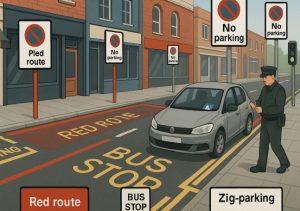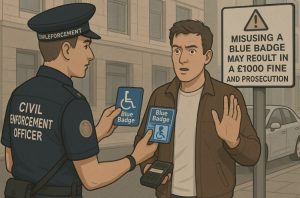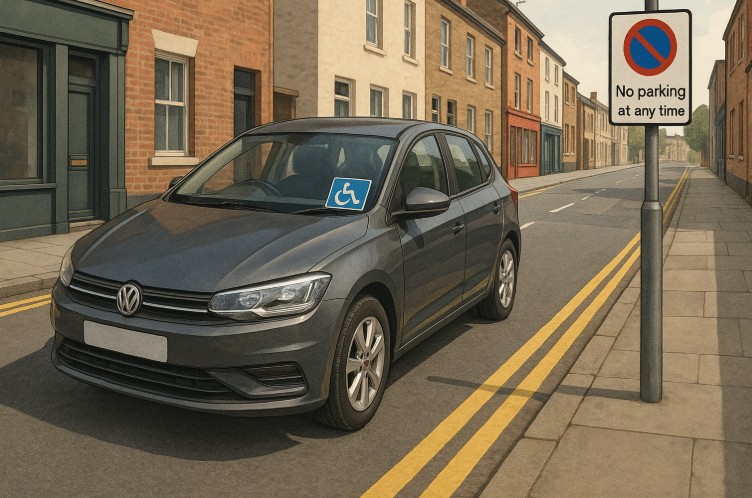Can Blue Badge holders legally park on double yellow lines? Understanding the rights and responsibilities under the Blue Badge Scheme is crucial for avoiding fines and ensuring safe, legal parking. While the badge offers essential concessions for those with mobility challenges, not all areas and rules are the same.
From local authority variations to restrictions in specific zones, this guide explores everything Blue Badge holders in the UK need to know about parking on double yellow lines.
What is the Blue Badge Scheme in the UK?

The Blue Badge Scheme is a government initiative designed to provide better access for people with severe mobility issues. It allows badge holders to park closer to their destination, whether they are the driver or a passenger.
The badge is primarily intended for on-street parking, and its privileges do not automatically extend to off-street car parks such as those at shopping centres, hospitals, or supermarkets.
Eligibility for a Blue Badge is determined by local councils and typically includes individuals with permanent disabilities, visual impairments, or those who have significant difficulty walking. The badge is personal and must only be used when the holder is travelling in the vehicle.
Use of the badge must comply with national guidance. Misuse, such as lending it to friends or using it when the badge holder is not present, is a criminal offence. Misuse can result in a fine of up to £1,000 and confiscation of the badge.
What Are Double Yellow Lines and Why Do They Matter?
Double yellow lines are a form of road marking used throughout the UK to indicate that waiting or parking is not permitted at any time. These restrictions are in place to ensure that traffic flows freely and safely, especially in busy urban environments or near critical access points such as junctions and schools.
For most road users, double yellow lines mean no stopping or waiting, with exceptions for loading or unloading if no additional restrictions are in place. However, Blue Badge holders may be permitted to park on these lines for a limited period, depending on local authority rules.
Understanding the meaning of double yellow lines is essential for all drivers, but especially for those with a Blue Badge who may be relying on those locations for access. Not all double yellow lines are the same, so signs and kerb markings must always be checked before leaving the vehicle.
Are Blue Badge Holders Allowed to Park on Double Yellow Lines?

Blue Badge holders are generally permitted to park on double yellow lines for up to three hours, provided no loading restrictions are in place. This parking allowance is crucial for individuals who need closer access to buildings or services and who may not find available disabled bays nearby.
To use this concession legally, the following conditions must be met:
- The Blue Badge must be clearly displayed on the dashboard with the hologram visible.
- The blue parking clock must also be displayed, set to the quarter-hour period when parking commenced.
- Parking must not obstruct traffic or pose a danger to pedestrians or other road users.
Kerb markings such as yellow dashes on the pavement edge indicate loading restrictions. If these are present, parking is not allowed even with a Blue Badge unless the local authority has made an exemption.
In central London, especially in boroughs such as Westminster or Kensington & Chelsea, parking rules can differ significantly. These areas may not offer standard Blue Badge concessions, so checking with the specific council is always advised.
What Are the Conditions and Time Limits for Parking?
Blue Badge holders are allowed to park on double yellow lines for up to three hours. However, there are strict conditions designed to prevent misuse and maintain road safety. The badge and clock must be displayed correctly, and the vehicle must not return to the same stretch of road within one hour of leaving.
The table below outlines the conditions:
| Parking Condition | Requirement |
| Display Blue Badge | Yes, on dashboard or facia panel |
| Display Blue Parking Clock | Yes, showing quarter-hour period of arrival |
| Maximum Duration | 3 hours |
| Return Restriction | Must wait 1 hour before returning to same spot |
| Allowed During Loading Restrictions | No, unless council provides exemption |
| Apply to Off-Street Car Parks | No, separate rules apply |
Incorrectly displayed badges or missing clocks can result in a Penalty Charge Notice. Faded or damaged badges must be replaced by the issuing council.
Where Else Can Blue Badge Holders Park Legally?

In addition to parking on double yellow lines under certain conditions, Blue Badge holders have access to various other parking concessions. However, it’s important to recognise the distinctions between on-street and off-street parking, and always check the rules set by local authorities.
On-Street Parking Locations
On-street parking is the primary area where Blue Badge concessions apply. This includes a range of public roads and designated spaces.
Designated Disabled Parking Bays
- Marked with a blue wheelchair symbol
- Typically located near shops, services, and public buildings
- Often without a time limit unless signs indicate otherwise
- Clock display may be required in time-limited bays
Pay-and-Display Bays and Parking Meters
- Blue Badge holders can usually park free of charge
- No time limit unless stated by signage
- Always display the badge clearly
- Clock not typically required, but useful for clarity
Single Yellow Lines
- Similar rules as double yellow lines apply
- Parking allowed for up to three hours
- Must not obstruct traffic or break loading restrictions
- Display badge and clock correctly
Free Parking Areas with Time Restrictions
- In areas where all motorists are allowed to park free for a limited time
- Blue Badge holders are often exempt from time limits
- If signage indicates a time limit for badge holders, the clock must be displayed
Off-Street Parking Locations
Blue Badge concessions do not automatically apply to off-street parking. These areas are usually under the control of private companies or institutions.
Supermarket and Retail Car Parks
- May offer dedicated disabled bays
- Rules set by the property owner
- Free parking is not guaranteed
- Always check signs or speak to customer service
Hospital Car Parks
- May provide accessible bays near entrances
- Charges and rules vary widely by NHS Trust
- Some offer discounts or exemptions for badge holders
Local Authority Car Parks
- Some councils offer free or discounted rates for badge holders
- Others enforce standard charges
- Always review terms at the car park entrance
Residential Permit Zones
- Some local councils allow Blue Badge holders to park in residents-only zones
- Others require a special permit
- Contact the local authority for permission and guidance
What Areas Are Still Off-Limits for Blue Badge Holders?

Although the Blue Badge scheme provides many valuable parking benefits, it does not permit parking in all locations. There are specific areas and conditions where parking is strictly prohibited, regardless of badge status.
Locations with Loading or Unloading Restrictions
- Marked by yellow kerb dashes
- Often accompanied by signs with time restrictions
- Badge holders cannot park here unless the local authority makes a specific exemption
- Risk of immediate fines or towing if violated
Pedestrian and Traffic Control Zones
Pedestrian Crossings
- Includes zebra, pelican, puffin, and toucan crossings
- Never park on the zig-zag lines before or after the crossing
- Designed to keep pedestrians safe and visible to traffic
Clearways and Urban Clearways
- Marked by signs prohibiting stopping or waiting
- Blue Badge concessions do not apply
- Only stopping to pick up or drop off passengers is permitted on urban clearways outside restricted hours
Bus Stops and Bus Lanes
- Bus stop clearways during operational hours are off-limits
- Parking in bus lanes is not allowed while they are in force
- These areas are monitored and often carry automatic fines
Central London Boroughs with Restricted Blue Badge Use
The full Blue Badge scheme does not apply in some central London areas due to specific traffic and parking control measures.
- City of Westminster
- Royal Borough of Kensington and Chelsea
- City of London
- Parts of the London Borough of Camden
These boroughs offer their own disabled parking concessions, which may differ from national guidance. It is essential to check local websites or contact the council directly before travelling.
Private Roads and Restricted Access Areas
- Includes private housing developments, university campuses, and business estates
- Parking allowed only with permission from the property owner
- The Blue Badge does not provide automatic access or rights
Dangerous or Obstructive Parking Locations
Even where badge holders are allowed to park, safety must come first. Parking in the following places is considered dangerous and can result in penalties:
- Near school entrances
- On bends, hills, or close to junctions
- Opposite or near traffic islands or roadworks
- Outside emergency access points such as hospital entrances
- Where the kerb is lowered for wheelchair access
- On pavements unless explicitly permitted
Parking in these locations may lead to:
- Penalty Charge Notices
- Vehicle removal
- Legal action or badge confiscation
What Should You Know About Local Authority Rules?
Local councils have significant control over how the Blue Badge scheme is implemented in their areas. Although national guidelines provide a baseline, many councils apply additional restrictions or provide extra benefits depending on local needs.
Some key points include:
- Boroughs such as Camden, Westminster, and Kensington & Chelsea have tailored rules for Blue Badge holders
- Some councils allow free parking in residents-only zones, others do not
- Enforcement officers have the authority to inspect badges and issue fines if misused
- Local rules can affect how long you can park or where you can use your badge
Always check your local council’s website or contact their parking services before travelling. Councils often publish maps and guidelines that outline where Blue Badge holders can park and for how long.
What Happens If Blue Badge Parking Rules Are Misused?

Blue Badge misuse undermines the purpose of the scheme and limits accessibility for genuine users. Misuse can occur when:
- The badge is used by someone other than the holder
- The badge holder is not present in the vehicle
- A photocopied or altered badge is displayed
- The badge is used after it has expired
Penalties for misuse include:
- A fine of up to £1,000
- Immediate confiscation of the badge by enforcement officers
- Possible criminal prosecution
Civil Enforcement Officers, traffic wardens, and police have the right to inspect the badge and request its surrender if they suspect it is being used illegally. They must carry identification, although some may operate in plain clothes.
To avoid unintentional misuse, always ensure:
- The badge is current and undamaged
- The photograph and hologram are visible
- The clock is correctly set when required
- Friends or family members are not using the badge without the badge holder present
How Can Drivers Ensure They’re Parking Correctly?
Proper use of the Blue Badge ensures safety, compliance with the law, and the integrity of the scheme. Key practices include:
- Checking for signage and local restrictions
- Displaying the badge face-up with the hologram visible
- Setting the clock accurately for timed locations
- Avoiding restricted zones and dangerous locations
- Replacing the badge if details become unreadable due to wear or fading
Blue Badge holders should also communicate these rules to anyone driving on their behalf. If the badge holder is not the driver, it becomes their responsibility to ensure the driver complies with all applicable regulations.
Conclusion
Blue Badge holders do benefit from certain parking exemptions, including limited use of double yellow lines. However, these privileges come with important conditions and responsibilities.
Proper display of the badge and clock, understanding local authority rules, and avoiding restricted or dangerous areas are all essential.
By following the official guidance, badge holders can ensure compliance while maintaining fair access for all. Always consult your local council and look out for road signage to park confidently and legally.
Frequently Asked Questions
Can a carer use the Blue Badge without the badge holder?
No, the Blue Badge must only be used when the holder is present in the vehicle, either as a driver or passenger. Using it without them is a criminal offence.
Do parking rules differ in Scotland, Wales, or Northern Ireland?
Yes, while the core Blue Badge rules are similar, local authorities may apply their own restrictions. It’s important to consult local councils when travelling.
Can Blue Badge holders park in residents-only zones?
In many areas, yes but not all. Some councils require a separate permit. Always check local signage or contact your council for clarity.
What should I do if my Blue Badge is not recognised by an enforcement officer?
You should explain the situation, present any supporting documents, and follow the appeals process if issued a penalty. Contact your local authority for guidance.
Are Blue Badge holders allowed to park on red routes?
Only in certain areas. Transport for London offers specific guidance. Always check signage or contact them in advance if unsure.
Is there an app to help find accessible parking spaces in the UK?
Yes, apps like Blue Badge Parking, AppyParking, and AccessAble can help locate nearby accessible parking spaces.
Can Blue Badge holders park on single yellow lines too?
Yes, under similar conditions to double yellow lines up to 3 hours, with the badge and clock displayed, unless local restrictions apply.








